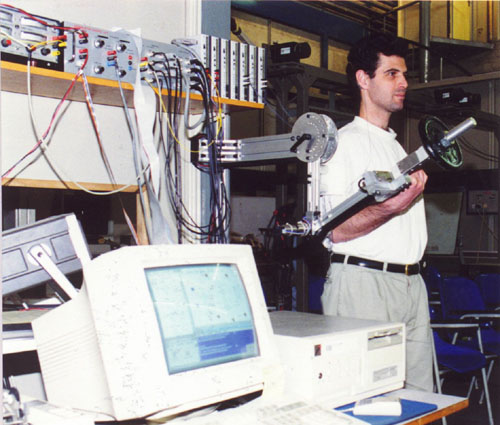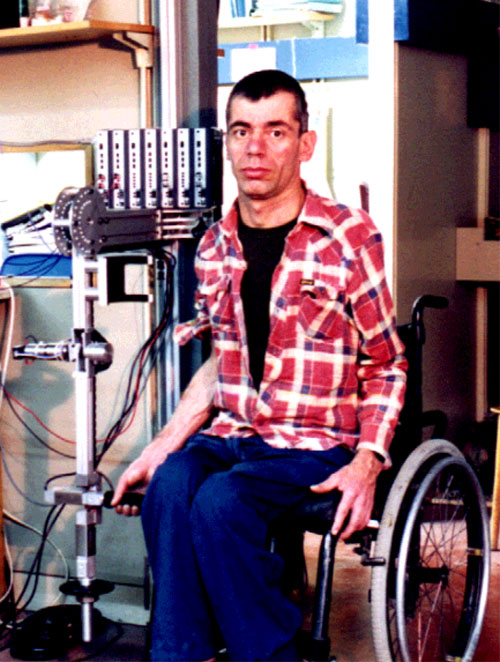Exoskeleton Prototype 1 (EXO-UL1)
The first exoskeleton mechanism consisted of a two-link, two-joint device corresponding to the upper and the lower arm and to the shoulder and elbow joints of the human body. The system included a weight plate (external load) that can be attached to the tip of the exoskeleton forearm link. The mechanism was fixed to the wall and positioned parallel to the sagittal plane of the operator. The human/exoskeleton mechanical interface included the upper arm bracelet, located at the upper arm link, and a handle grasped by the operator. This two-joint mechanism was used as a one-degree of freedom system by fixing the system shoulder joint at specific angles in the range of 0-180 Deg. The elbow joint was free to move in an angle range of 0-145 Deg, and included built-in mechanical constraints which kept the exoskeleton joint angle within the average human anthropometric boundaries. Since the human arm and the exoskeleton were mechanically linked the movements of the forearms of both the human and the exoskeleton were identical.
The basic purpose of the exoskeleton system as an assistance device is to amplify the moment generated by the human muscles relative to the elbow joint, while manipulating loads. The exoskeleton's elbow joint was powered by a DC servo motor (ESCAP-35NT2R82) with a stall torque of 360 mNm equipped with a planetary gearbox (ESCAP-R40) with a gear ratio of 1:193 and a maximal output torque of 40 Nm. An optical incremental shaft encoder (HP HEDS 5500) with 500 lines was attached to the motor shaft. Due to the encoder location and the high gear ratio, the practical encoder's resolution for measuring the joint angle was 0.0036 Deg. This setup incorporated a DC motor with the highest torque-to-weight ratio that was available on the commercial market at that time with a power consumption that could be provided by a battery. A high energy density of the power supply and an actuator with a high torque-to-weight ratio are two key features of the exoskeleton system as a self contained mobile medical assistance device for the disabled community. Limits imposed by present technology on these two key components along with design requirements for developing a compact system with a potential of serving as a medical assistance device for disabled person restricted the payload to be 5 Kg. However, this biomedical oriented design does not restrict the generality of the exoskeleton concept or its operational algorithms. Using other actuation systems, like hydraulic system increases the load capacity substantially.
The exoskeleton forearm was extended by a rod with a special connector for attaching disk-type weights (external load). Two force sensors (TEDEA 1040) were mounted at the interfaces between the exoskeleton and the tip carrying the external load and between the exoskeleton and the human hand. The first load cell, inserted between the rod holding the external load and the exoskeleton forearm link, measured the actual shear force, normal to the forearm axis, applied by the external load. The second load cell was installed between the handle grasped by the human hand and the forearm link of the exoskeleton. This load cell measured the shear force applied by the operator to the handle. Multiplying the sensors' measurements by the corresponding moment arms indicated the moments applied by the weights and by the human hand relative the elbow joint.


Surface EMG electrodes (8 mm Ag-AgCl BIOPAC - EL208S) were attached to the subject’s skin by adhesive disks for measuring the EMG signal of the Biceps Brachii and Triceps Brachii medial-head muscles. The signals were gained by EMG amplifiers (BIOPAC - EMG100A) using a gain factor in the range of 2000-5000 (depending on the subject). The EMG signals and the load cell signal were acquired by an A/D convector (Scientific Solution Lab Master 12 bit internal PC card) with a 1 kHz sampling rate, whereas the encoder signals were counted by custom-made hardware. The entire data set was recorded simultaneously and stored, for later off-line analysis and simulation.
A special real-time software, for operating the system, was written in C and run on a PC-based platform. The software was composed of three main modules. The first module dealt with the hardware/software interface. It controlled the interaction between the PC and the external motor driver and the sensors, through a D/A and an A/D card. The second module included the automatic code generated by the MATLAB - Simulink Real-Time toolbox. The third module was the user interface module which allowed to set various run time operational parameters. All the modules were compiled and linked for generating an efficient real-time software.
Projects
Performance Evaluation of a One DOF Myosignal-Based Powered Exoskeleton System
Device: Exoskeleton Prototype 1 - Active Mode (Real-Time)
Methodology: Human Subjects - Real-Time Human Muscle Simulation
Status: Completed
Performances of Hill-Type and Neural Network Muscle Models - Towards a Myosignal Based Exoskeleton
Device: Exoskeleton Prototype 1 - Passive Mode
Methodology: Human Subjects - Off-Line Muscle Modeling / Simulation
Status: Completed
PUblications
(*) Note: Most of the Bionics Lab publications are available on-line in a PDF format. You may used the publication's reference number as a link to the individual manuscript.
Rosen J., M. B. Fuchs, and M. Arcan, Performances of Hill-Type and Neural Network Muscle Models - Towards a Myosignal Based Exoskeleton, Computers and Biomedical Research, Vol. 32, No. 5, pp. 415-439, October 1999. [![]() JP3]
JP3]
Rosen J., M. Brand, M. Fuchs and M. Arcan, A Myosignal-Based Powered Exoskeleton System, IEEE Transactions on System Man and Cybernetics - Part A: Systems and Humans, Vol. 31, No. 3, pp. 210 - 222, May 2001 [![]() JP6].
JP6].
Rosen J., M. Brand, M. Fuchs, M. Arcan, An Upper Limb Myosignal-Based Powered Exoskeleton System, Exoskeletons for Human Performance Augmentation (EHPA) Workshop - DARPA, Washington, D.C., March 1-3, 2000. [Slide Presentation ].
Rosen J., Natural Integration of a Human Arm / Exoskeleton System, Ph.D. Dissertation, Tel-Aviv University, Israel, May 1997
Multimedia
Exoskeleton Prototype 1
System overall view.
[ MPG 4.3 MB ]
The Exoskeleton system as an assistive device.
[ MPG 3.6 MB ]
The Exoskeleton system in a teleopration mode.
[ MPG 3.3 MB ]
The Exoskeleton system operated by a disabled person as an assistive device.
[ MPG 1.8 MB ]